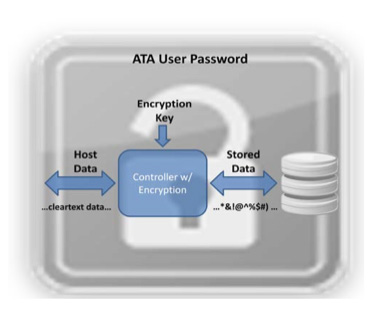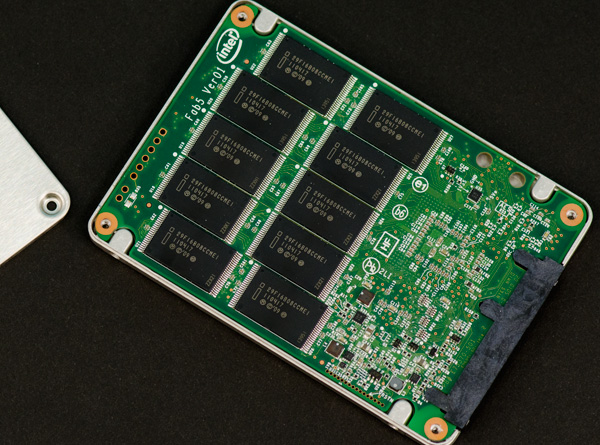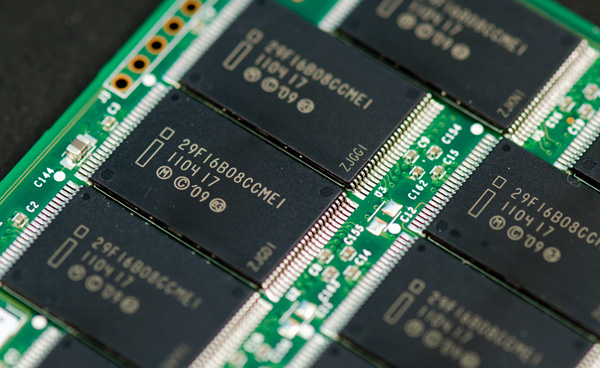The Intel SSD 320 Review: 25nm G3 is Finally Here
by Anand Lal Shimpi on March 28, 2011 11:08 AM EST- Posted in
- IT Computing
- Storage
- SSDs
- Intel
- Intel SSD 320
Spare Area and Redundant NAND
Intel's controller is a 10-channel architecture and thus drive capacities are still a little wonky compared to the competition. Thanks to 25nm NAND we now have some larger capacities to talk about: 300GB and 600GB.
Intel sent a 300GB version of the 320 for us to take a look at. Internally the drive has 20 physical NAND devices. Each NAND device is 16GB in size and features two 64Gbit 25nm 2-bit MLC NAND die. That works out to be 320GB of NAND for a drive whose rated capacity is 300GB. In Windows you'll see ~279GB of free space, which leaves 12.8% of the total NAND capacity as spare area.
Around half of that spare area is used to keep write amplification low and for wear leveling, both typical uses of spare area. The other half is for surplus NAND arrays, a RAID-like redundancy that Intel is introducing with the SSD 320.
As SandForce realized in the development of its controller, smaller geometry NAND is more prone to failure. We've seen this with the hefty reduction in rated program/erase cycles since the introduction of 50nm NAND. As a result, wear leveling algorithms are very important. With higher densities however comes the risk of huge amounts of data loss should there be a failure in a single NAND die. SandForce combats the problem by striping parity data across all of the NAND in the SSD array, allowing the recovery of up to a full NAND die should a failure take place. Intel's surplus NAND arrays work in a similar manner.
Instead of striping parity data across all NAND devices in the drive, Intel creates a RAID-4 style system. Parity bits for each write are generated and stored in the remaining half of the spare area in the SSD 320's NAND array. There's more than a full NAND die (~20GB on the 300GB drive) worth of parity data on the 320 so it can actually deal with a failure of more than a single 64Gbit (8GB) die.
Sequential Write Cap Gone, but no 6Gbps
The one thing that plagued Intel's X25-M was its limited sequential write performance. While we could make an exception for the G1, near the end of the G2's reign as most-recommended-drive the 100MB/s max sequential write speed started being a burden(especially as competing drives caught up and surpassed its random performance). The 320 fixes that by increasing rated sequential write speed to as high as 220MB/s.
You may remember that with the move to 25nm Intel also increased page size from 4KB to 8KB. On the 320, Intel gives credit to the 8KB page size as a big part of what helped it overcome its sequential write speed limitations. With twice as much data coming in per page read it's possible to have a fully page based mapping system and still increase sequential throughput.
Given that the controller hasn't changed since 2009, the 320 doesn't support 6Gbps SATA. We'll see this limitation manifest itself as a significantly reduced sequential read/write speed in the benchmark section later.
AES-128 Encryption
SandForce introduced full disk encryption starting in 2010 with its SF-1200/SF-1500 controllers. On SandForce drives all data written to NAND is stored in an encrypted form. This encryption only protects you if someone manages to desolder the NAND from your SSD and probes it directly. If you want your drive to remain for your eyes only you'll need to set an ATA password, which on PCs is forced by setting a BIOS password. Do this on a SandForce drive and try to move it to another machine and you'll be faced with an unreadable drive. Your data is already encrypted at line speed and it's only accessible via the ATA password you set.

Intel's SSD 320 enables a similar encryption engine. By default all writes the controller commits to NAND are encrypted using AES-128. The encryption process happens in realtime and doesn't pose a bottleneck to the SSD's performance.
The 320 ships with a 128-bit AES key from the factory, however a new key is randomly generated every time you secure erase the drive. To further secure the drive the BIOS/ATA password method I described above works as well.
A side effect of having all data encrypted on the NAND is that secure erases happen much quicker. You can secure erase a SF drive in under 3 seconds as the controller just throws away the encryption key and generates a new one. Intel's SSD 320 takes a bit longer but it's still very quick at roughly 30 seconds to complete a secure erase on a 300GB drive. Intel is likely also just deleting the encryption key and generating a new one. Without the encryption key, the data stored in the NAND array is meaningless.
The Test
| CPU |
Intel Core i7 965 running at 3.2GHz (Turbo & EIST Disabled) Intel Core i7 2600K running at 3.4GHz (Turbo & EIST Disabled) - for AT SB 2011, AS SSD & ATTO |
| Motherboard: |
Intel DX58SO (Intel X58) Intel H67 Motherboard |
| Chipset: |
Intel X58 + Marvell SATA 6Gbps PCIe Intel H67 |
| Chipset Drivers: |
Intel 9.1.1.1015 + Intel IMSM 8.9 Intel 9.1.1.1015 + Intel RST 10.2 |
| Memory: | Qimonda DDR3-1333 4 x 1GB (7-7-7-20) |
| Video Card: | eVGA GeForce GTX 285 |
| Video Drivers: | NVIDIA ForceWare 190.38 64-bit |
| Desktop Resolution: | 1920 x 1200 |
| OS: | Windows 7 x64 |













194 Comments
View All Comments
piquadrat - Monday, March 28, 2011 - link
Theoretically for working encryption you need bios with ATA password support. If you're out of luck there is also a way to mod existing bios and add appropriate extension, but skills and experience required.The thing is:
There is no evidence that BIOS password in intel's implementation is LINKED to AES password generated by internal cypher engine!!!
If not, this solution is no different than SF-1200 non-enterprice drives. You can enable ATA pass on OCZ Vertex2 but it is not used to hash internal encryption keys which effectively renders the whole AES thing USELESS (security wise).
wvh - Tuesday, March 29, 2011 - link
Thanks... But I'm even more confused now. ;)piquadrat - Tuesday, March 29, 2011 - link
Lets wait until some further details concerning intel's implementation make to the public. I'm sure that early adopters will test this feature thoroughly. Now all of this is mainly academic.danjw - Monday, March 28, 2011 - link
Have you forgotten the P67 fiasco already?neotiger - Monday, March 28, 2011 - link
So after all these delays Intel released a product that can just barely keep up with the LAST generation of competing products. Meanwhile, competitors are releasing new gen of products at significant performance increases.In other words, Intel just GAVE UP on the top end of the market and is now just trying to be the cheapest product.
Truly disappointing.
FXi - Monday, March 28, 2011 - link
$1069 for a product only guaranteed to work 3 (THREE) years. IF it fails after that time, you've paid over $350 a year for storage. The 300 works out to $190, almost $200 PER YEAR for storage.If Intel feels so confident that these things will last, do the same as the rest of the enterprise grade industry and give it 5 years of "we're positive it will work this long".
Watch the rest of the SSD market cry if Intel does this, but they won't. These things are bad enough if something goes wrong at year 2 or 3, but past that it's the wild west. And given the prices, that shouldn't be the case.
$1069 is a decent price. $999 would have been excellent, but either price is horrible when compared to only a 3 year guaranteed lifespan.
iwod - Monday, March 28, 2011 - link
Personally i think it is too expensive. But,1. It would still sell very well. Because 90% of users are still with SATA 3Gbps. And Intel Drives are the most reliable SSD out there, currently its pricing is not cheap, but competitive.
2. Intel aren't keeping up with production volume anyway for their 25nm SSD. ( Note most of the Intel 25nm NAND sold to other company are proberly Tier -2 Bin NAND )
Yeah, we are disappointed, but it is still going to do well.
Let's Hope Future Intel SSD will beat even the Sandforce 2200 Series.
Lingyis - Monday, March 28, 2011 - link
Reliability is a big issue! I'm not a super-techie, but as a user, having experienced 2 out of 3 Vertex drives that I ended up having to reinstall the OS (once Windows 7, once Mac on my wife's machine) within 6 months, I have reverted to using good'ol hard drives for myself.Intel's higher reliability might be good enough--but hard drives are still more reliable. (if anybody has hard statistics to back me up i'd highly appreciate it)
sean.crees - Tuesday, March 29, 2011 - link
I've personally had MUCH more issues with HDD's than SSD's. Though that likely has to do with the fact that the only SSD's I've worked with are my 2x 1st gen 80g Intel SSD's, and I've spent the last 15 years dealing with HDD's.My biggest issue with HDD's is exposure to heat. I've lost my A/C in the summer, and then subsequently lost all my data on my HDD's because it got too hot for them. You don't have this problem with SSD's.
Also, any tech device is going to have DOA's. Just because you got a bad batch, doesn't mean the entire industry as a whole is worse than older tech. And, OCZ has come a LONG way since their initial reliability issues with their 1st gen Vertex drives. They have listened to their customers, and listened to reviewers like Anand, and have implemented changes to make their products meet our expectations. This one simple act above all else is what pulls me away from the Intel camp to purchase a Vertex 3 for my next SSD.
jwilliams4200 - Tuesday, March 29, 2011 - link
Are you insane? OCZ is meeting expectations?How could you have missed that just in the last few months, OCZ has changed their products to be lower performing and less capacity than previously, without informing customers or even changing the product SKU? Or that OCZ uses Spectek flash instead of higher-tier Micron flash memory in some of their SSDs, but a customer cannot know which flash they got without opening the SSD and voiding their warranty?
OCZ are nothing but con men and spin doctors. If you think OCZ cares about their customers and treats them with honesty and respect, then you are awfully naive.
Besides, the statistics show that Intel is the most reliable SSD. Even without the statistics, it is easy to see why Intel is more reliable. Intel uses the highest quality parts, including getting the highest bin flash memory from their manufacturing lines, and Intel testing and quality control is a corporation wide thing. I doubt OCZ even knows the meaning of the words.